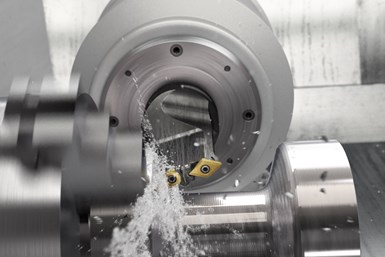Sandvik Coromant Turning Tools Enable Y-Axis Turning
The company has developed two new tools to support Y-axis turning: CoroTurn Prime and the CoroPlex YT twin-tool.
Share



Sandvik Coromant has developed a method for turning that uses the Y-axis for complicated shapes and pockets with a single tool. The method is said to offer reduced cycle time, improved component surface quality and more stable machining.
The new turning method makes use of the Y-axis, and all three axes are used simultaneously when machining. The tool rotates around its own center, with the insert placed for machining in the Y-Z plane, and the milling spindle axis interpolates during turning. Sandvik Coromant says this enables intricate shapes to be machined with a single tool.
Two new tools have been developed to support Y-axis turning. The new CoroTurn Prime variant is suitable for shafts, flanges and components with undercuts. The CoroPlex YT twin-tool, which features CoroTurn TR profiling inserts and CoroTurn 107 round inserts with rail interface and can be used for components with pockets and cavities.
Y-axis turning offers the ability to machine several features with a single tool, and no tool changes are required, which minimizes the risk of “blend points” or irregularities between adjacent machined surfaces. The main cutting forces are directed into the machine spindle, improving stability and reducing the risk of vibration. A constant entering angle is said to drastically improve chip control and help avoid chip jamming.
Turning has developed in recent years with new innovations, such as all-directional PrimeTurning, non-linear turning and interpolation turning. “One could say that these advances, together with progressive capabilities in modern machines and CAM software, have paved the way for the new Y-axis turning method,” says Staffan Lundström, turning product manager at Sandvik Coromant. “And with the tools and method now in place, we look forward to exploring the possibilities this method can present to our customers.”
Related Content
-
Orthopedic Event Discusses Manufacturing Strategies
At the seminar, representatives from multiple companies discussed strategies for making orthopedic devices accurately and efficiently.
-
Choosing the Right Drill Type
Specifying the right option for your application can save time and tools.
-
5 Tool Setting Techniques
Each tool setting technique has merit, and it depends on where you are as a shop and the type of work you do, as cost and efficiency all come into play.























